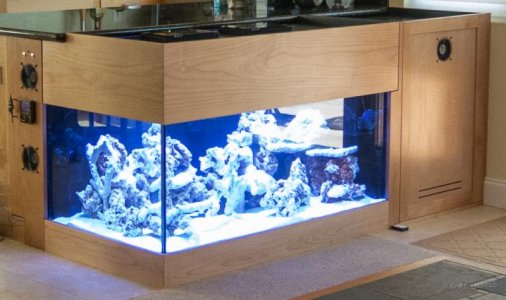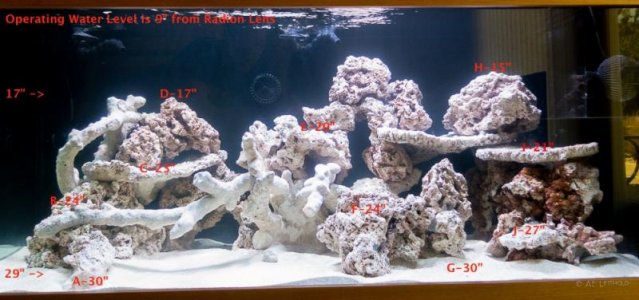I finally got around to doing PAR measurements in my new tank build this morning prior to introducing first inhabitants in a couple of weeks, and thought I would share results since practical G3 wide-angle lens info is fairly lacking from the research I've tried to do the last few months. In addition, I really appreciate Eastanherstbias' previous work here, so I have included my own general 9", 17", and 29" measurements to provide an approximation of PAR between normal and wide-angle lenses should you want to give that a go -- even with all the variables that entails. The top greyed-out section of my table have measurements taken directly underneath one of my Radions --
or as close as I could do it. Most other measurements on my aquascape are naturally offset from the center, and that distance effects PAR as you'll see. I'll let you draw your own conclusions. I'm still formulating my own.
Background: I have 2 Radion G3 Pros with optional Wide-Angle TIR lenses over my 160gal 54"Lx30"Wx24"H reef. The Radions are seated on top of a hood that is painted inside with high-gloss white; The fixtures are centered front-to-back over the 30" wide tank and are just 6.25" apart length-wise (they are purposely not equidistant over the tank -- but pushed towards the center); The bottom of the lenses are 9" over the water operating level. As a side note, I really like the way these wide-angle lenses decrease shadows in my wide tank, but even more than expected, it comes with a substantive cost of PAR at the same time...
There are three attachments:
1)
Da Reef Orientation Photo -- to give you a visual how the Radions are mounted on the hood over the tank
2)
Da Reef Front View Depth Annotated -- a head-on view of my aquascape with a legend of the points measured
3)
Radion Pro G3 Wide TIR PAR PDF -- The data points
Caveats: This is not scientific. There was variability with moving PAR readings in my real tank as my hand/PVC and the current manipulated the exact orientation of the sensor -- I've recorded a rough average of the readings over a several-second timeframe without regard to any other measurements I was trying to also record. ...and because of those "moving measurements", some of the specific numbers don't make logical sense if taken as absolutes when now compared side-by-side, but provide what I was after for my own purpose, given a few hours work putting this together and then attempting to document for the forum to hopefully help someone else one day. If you don't think this is useful, please ignore it vs taking the time to respond with a flame. 







